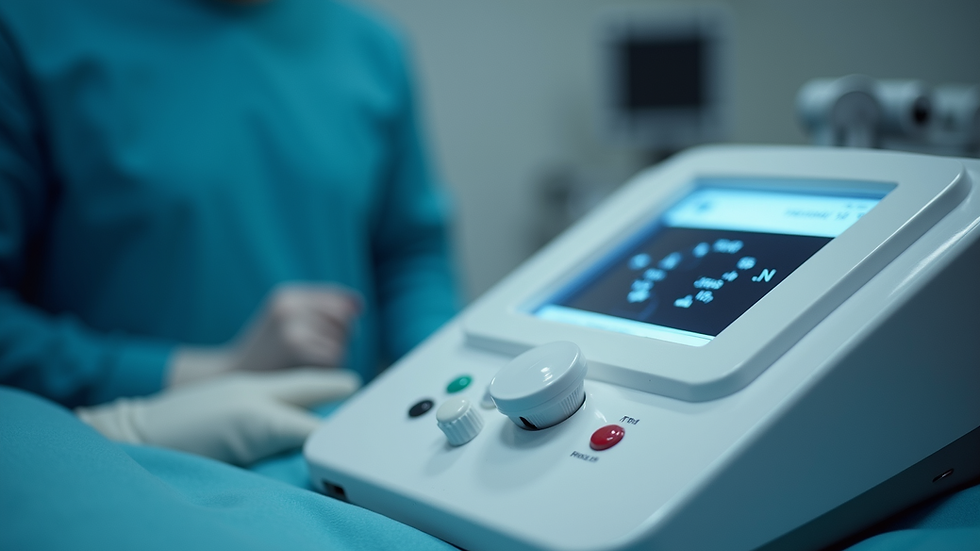Relieving Pelvic Pain with Shockwave Therapy
- Fabio Castiglione

- 3 minutes ago
- 4 min read
Pelvic pain is a common issue that affects many individuals, often causing significant discomfort and impacting daily life. Traditional treatments may include medications, physical therapy, or even surgery, but a newer and less invasive option is gaining traction: shockwave therapy. This innovative technique offers a non-surgical approach to relieving pelvic pain effectively. In this post, we'll explore how shockwave therapy works, its benefits, and practical steps for individuals experiencing pelvic pain.
Pelvic Pain Shockwave Therapy
Shockwave therapy, medically known as extracorporeal shock wave therapy (ESWT), has soared in popularity as an effective treatment for various musculoskeletal conditions, including pelvic pain. The therapy involves sending acoustic waves to the affected area, promoting healing and pain relief.
These waves stimulate blood circulation, break down scar tissue, and encourage cell regeneration, which ultimately helps alleviate pain. Studies indicate that patients undergoing shockwave therapy have reported significant improvements in their pelvic pain symptoms. One study revealed that up to 75% of patients experienced positive results after a course of treatment.

The therapy sessions typically last 15 to 30 minutes, and most patients require multiple sessions to achieve optimal results. Often, treatment can be performed in an outpatient setting, making it a convenient option for those with busy schedules.
Understanding Pelvic Pain
Pelvic pain can originate from various sources, including the reproductive organs, urinary tract, or digestive system. Common causes may include menstrual cycles, pelvic inflammatory disease, interstitial cystitis, or endometriosis. This pain can be acute, lasting for a short period, or chronic, persisting for months or even years.
It’s essential to consult with a healthcare provider to accurately diagnose the underlying issue. Imaging studies or a pelvic exam may be necessary to determine the cause and appropriate treatment.
How to Relieve Severe Pelvic Pain?
Relieving severe pelvic pain often requires a multi-faceted approach. Here are several practical strategies that can help:
Over-the-counter pain relief:
Medications like ibuprofen or naproxen can help manage pain and reduce inflammation. Always consult a physician before starting any medication.
Physical therapy:
A physical therapist specializing in pelvic pain can develop a tailored exercise plan to strengthen pelvic muscles and improve flexibility.
Heat therapy:
Applying a heat pack or warm compress can relax tense muscles and promote blood flow.
Relaxation techniques:
Mindfulness meditation, yoga, or deep-breathing exercises can reduce stress and tension, helping to alleviate pain.
Dietary adjustments:
Certain foods may exacerbate pelvic pain. Keeping a food diary to track symptoms can help identify potential triggers.
Shockwave therapy for pelvic pain:
Those interested in non-invasive treatment options may consider shockwave therapy. This innovative approach can provide significant pain relief and improve quality of life.

The Benefits of Shockwave Therapy
Shockwave therapy offers several advantages that make it an attractive option for those suffering from pelvic pain:
Non-invasive: Unlike surgical interventions, shockwave therapy does not require any cuts, anesthesia, or recovery time.
Minimal Side Effects: Most patients experience minimal side effects, with some reporting mild discomfort during treatment that subsides quickly.
Quick Recovery: Many patients return to their regular activities almost immediately after each session.
High Success Rate: With a success rate of up to 75%, shockwave therapy has shown promising results for relieving pelvic pain.
What to Expect During Treatment
Before undergoing shockwave therapy, it's crucial to have a consultation with a healthcare provider. They will assess your condition and outline a personalized treatment plan. During the session, a gel will be applied to the pelvic area to help the acoustic waves effectively penetrate the skin.
The therapist will then use a handheld device that emits the shockwaves. Patients may experience a mild tingling sensation or a brief moment of discomfort, but the treatment is generally well-tolerated.

Aftercare and Recovery
After the treatment, patients may resume their daily activities immediately. However, it’s advisable to avoid high-impact exercises or heavy lifting for a day or two post-treatment. Most patients will see gradual improvement over time, but the full benefits may take several weeks to manifest.
For optimal results, it’s essential to follow the healthcare provider’s recommendations and complete the necessary sessions as outlined in your treatment plan.
Support and Resources
Living with pelvic pain can take a toll on emotional well-being. Consider connecting with support groups or counseling to share experiences and learn coping strategies. Many resources are available online, including forums, articles, and local support groups that focus on pelvic pain management.
Educating oneself about the condition also fosters empowerment. Understanding the anatomy, potential causes, and treatments can help demystify the experience of pain and lead to informed discussions with healthcare providers.
Exploring Further Options
If you or a loved one is grappling with pelvic pain, it’s vital to explore all available treatment options. While shockwave therapy presents a promising avenue, other treatments may also complement this therapy effectively.
Alternative therapies such as acupuncture, chiropractic care, or aromatherapy could also provide relief. Always consult with healthcare providers to determine the most appropriate strategies tailored to individual needs.
Your Journey Toward Recovery
Combating pelvic pain is often a journey that requires patience and persistence. Whether considering shockwave therapy or another treatment option, finding a plan aligned with your lifestyle and health needs is essential. Focus on self-care, maintain open communication with healthcare providers, and remember that relief is possible.
Ultimately, embracing a proactive approach to managing pelvic pain can lead to improved well-being and a better quality of life. If you continue to experience discomfort, don't hesitate to seek professional guidance. Each step taken toward understanding and managing pain is a stride toward a pain-free life.







Comments